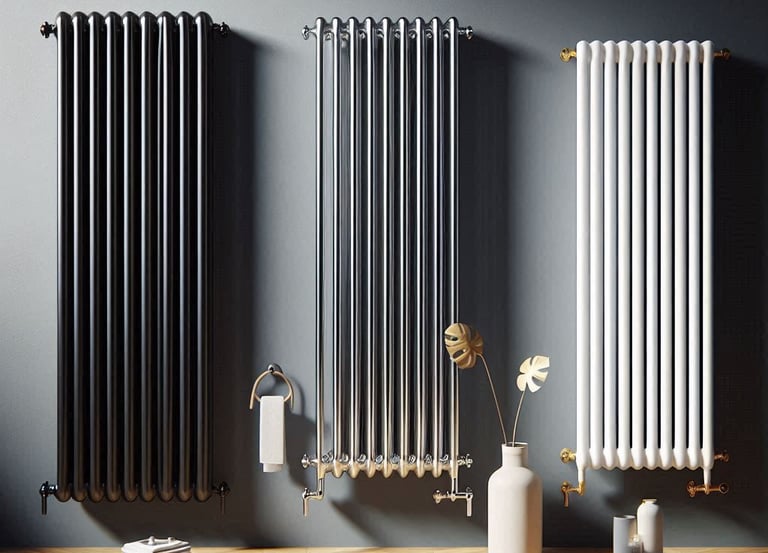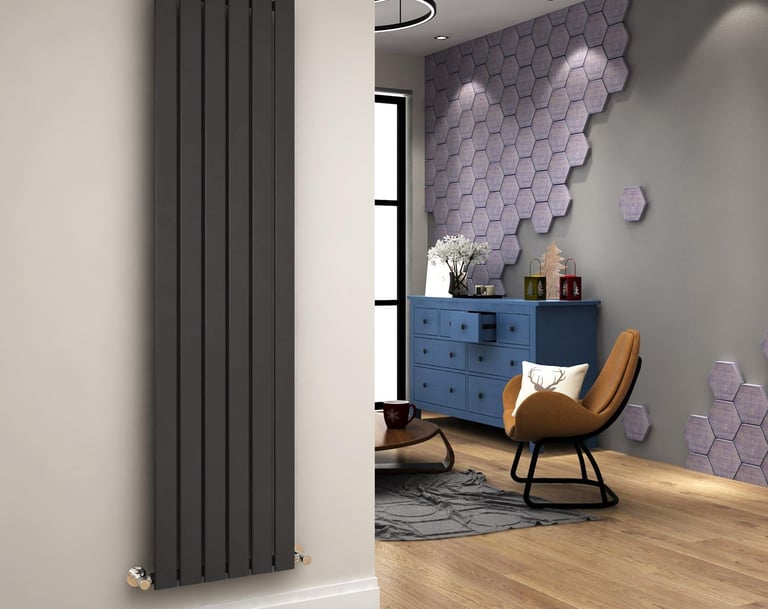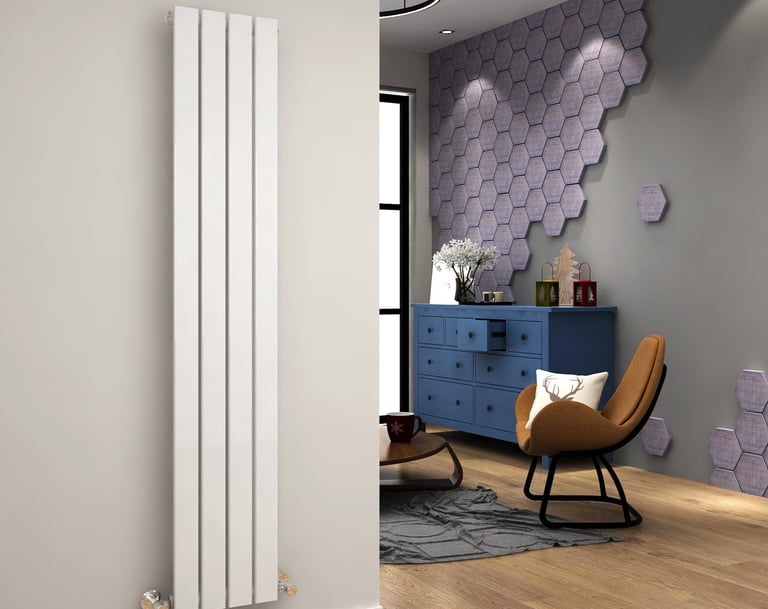
Radiators
Shop now to choose your perfect radiator delivered directly to your door.
Advice
Read our article below, to get the low down on what to consider when you buy your radiators.
Understanding BTU Output for Your Room Size
One of the critical factors when selecting a radiator is its BTU (British Thermal Units) output. BTU output is a measure of the radiator’s efficiency in heating a specified space. Ensuring the right BTU output for your room size is imperative for achieving optimal warmth and energy efficiency. A radiator with too low a BTU output will struggle to heat the room adequately, while one with too high an output will waste energy, leading to unnecessarily high heating costs.
Calculating the required BTU output involves taking into account several variables, including room size, insulation quality, and window size and placement. The basic formula for estimating the needed BTU is to first measure the room dimensions: length, width, and height. Multiplying these three dimensions will give you the room's volume in cubic feet or cubic meters.
However, volume alone is not sufficient. Insulation quality is another crucial element; better-insulated rooms will require fewer BTUs for heating. For instance, older homes with poor insulation might need a higher BTU output. Windows also play a role; larger windows or single-glazed windows can lead to heat loss, thereby necessitating a higher BTU output.
To simplify this process, many online BTU calculators are available, which require you to input room dimensions, insulation quality, and window information. These calculators quickly provide an estimated BTU requirement tailored for your specific scenario. Additionally, BTU charts can offer rough estimates based on room size alone, though these should be used as a guideline rather than a precise calculation.
Once you have identified the requisite BTU output for your room, compare this with the BTU ratings on potential radiators. Always ensure the chosen radiator aligns with the calculated BTU requirement. This careful selection will ensure both comfort and energy efficiency, providing a well-heated space without unnecessary expenditure.
Delta T Ratings: T50, T60, and T70 Explained
When you're shopping for a radiator, it's essential to know how to compare one model to another effectively. The key to this is understanding the radiator's BTU (British Thermal Unit) rating, which measures its heat output. However, the way BTU is calculated can vary depending on the boiler temperature used in the calculations. This variation can lead to confusion if manufacturers and retailers aren't consistent in their methods.
Imagine if there were different reference points for boiler temperatures—that would be pretty confusing, right? Unfortunately, this is exactly the case, as there are two common standards: Delta 50 and Delta 60 and even Delta 70.
So What is Delta T?
Delta T is calculated by taking the temperature of the water flowing into the radiator and the temperature of the water flowing out. For example, if the input is 80 degrees and the output is 60 degrees, the average temperature of the radiator would be 70 degrees.
A standard "Room Temperature" is considered to be 20 degrees. Subtracting this from the average radiator temperature leaves you with a Delta T of 50 degrees (Delta T50).
Delta T50 vs. Delta T60 vs. Delta T70
Delta T50 is the standard in Europe and, more recently, in the UK since 2013. It is based on a lower expected boiler temperature, which aligns with modern energy efficiency goals and concerns about climate change. Delta T60, which was the previous standard in the UK, is still in use but is becoming less common. Delta T70 is rarely used and is generally specific to certain suppliers. If you come across a BTU rating based on Delta T70, it's advisable to convert it to Delta T50 or Delta T60 for easier comparison.
How to Convert Between Delta T50, T60, and T70
Here’s how you can convert between these different Delta T ratings:
The easiest way to convert between different deltas, is to use the HeatSenseHub.com delta converter here
Or if you like a bit of maths you can do the below!.
To convert a radiator’s heat output from Delta T60 to Delta T50, multiply the BTU by 0.789.
For example: A radiator with a 5000 BTU rating at Delta T60 would have 3945 BTU at Delta T50 (5000 * 0.789 = 3945 BTU).
To convert from Delta T60 to Delta T70, multiply the BTU by 1.223.
For example: A radiator with a 5000 BTU rating at Delta T60 would have 6115 BTU at Delta T70 (5000 * 1.223 = 6115 BTU).
To convert from Delta T50 to Delta T60, multiply the BTU by 1.264.
For example: A radiator with a 4200 BTU rating at Delta T50 would have 5309 BTU at Delta T60 (4200 * 1.264 = 5309 BTU).
Why Delta Rating Matters
When purchasing a radiator, BTU ratings are a crucial factor to consider. Ideally, you’ll use a BTU calculator to determine your needs, but regardless of whether you need 500 or 5000 BTU, it’s vital that the rating you’re looking at is accurate. Even a small discrepancy can make a significant difference—for instance, a radiator advertised as 1000 BTU might be slightly off, but what if it were 25% less effective than expected?
This scenario can happen if one retailer uses Delta T60 or T70 ratings while another uses Delta T50. The first store's radiators might seem more powerful and better value, but this could be misleading. Some retailers might not disclose that their BTU figures are based on Delta T60 instead of Delta T50, which can result in consumers unknowingly purchasing less efficient radiators. Whether this happens intentionally or accidentally, it can end up costing you more in the long run as the radiators may not be sufficient to heat the required room.
The Bottom Line
Radiators Deltas are either Delta T50,T60 or even T70, this in itself is not a huge issue as long as the person buying realises this.
The important thing is you know what delta you are calculating your room for and know what Delta the radiators are shown at.
In simple terms, it is vital you establish which Delta-T the radiators advertised BTU output are measured at.
It's no good establishing you need 10,000 BTU radiator at Delta 50 , but then buying a radiator with 10,000 BTU output at Delta-70 as when you convert that same rad to Delta 50 it will be far less than the 10,000 BTU you need.
It may seems confusing and it can cause issues sometimes, but most retailers and manufacturers state what Delta their radiators are and are open and honest about it and always happy to help with any questions, so if in doubt just ask them for advice.
Material Choices: Stainless Steel, Aluminium, and Mild Steel
In the realm of radiator construction, the choice of material is instrumental in determining the performance and longevity of the unit. Stainless steel, aluminium, and mild steel are the predominant materials used, each bringing distinct advantages to the table.
Stainless steel radiators are renowned for their exceptional durability and high resistance to corrosion. This makes them an ideal choice in environments where exposure to moisture is a concern, such as bathrooms or coastal areas. Additionally, stainless steel retains its sleek, polished appearance over time, offering both functionality and modern aesthetics. However, stainless steel radiators usually come at a higher price point, reflecting their superior quality and longevity.
On the other hand, aluminium radiators are celebrated for their lightweight nature and outstanding heat conduction capabilities. Aluminium quickly radiates heat, making it highly efficient in warming up spaces rapidly. This efficiency can translate into reduced energy consumption, offering both cost savings and environmental benefits. The downside is that aluminium radiators may be more susceptible to dents and require more careful handling and maintenance compared to other materials.
Mild steel radiators are often considered the most versatile and cost-effective option. They strike a balance between durability and affordability, making them a popular choice for many households. Mild steel radiators are available in a wide range of styles and sizes, accommodating diverse aesthetic preferences and functional requirements. However, they may be prone to rust over time, particularly if the coating wears away, necessitating occasional maintenance to extend their lifespan.
In summary, selecting the right material for your radiator involves evaluating the specific demands of your environment and your personal preferences. Whether prioritizing durability with stainless steel, energy efficiency with aluminium, or affordability with mild steel, understanding these nuances will help ensure that your choice meets both the performance and aesthetic needs of your space.
Selecting the appropriate radiator dimensions is crucial to ensure it fits seamlessly within your designated space. The first step is to measure the available area accurately. It is advisable to measure the height, width, and depth of the space where you intend to install the radiator. When measuring the height, consider any obstructions like windowsills or shelves that might constrain your options. For width, ensure there is enough room on the walls, taking into account any furniture or fixtures that could impede installation.
Once you have the precise dimensions, compare them with the radiator's specifications. Modern radiators come in various sizes, from compact models designed for small rooms to larger units suited for spacious areas. A critical factor is to match the radiator's dimensions to your room’s needs without compromising on heating efficiency.
Installation considerations are also fundamental when selecting a radiator. Wall-mounted radiators are a popular choice for their space-saving benefits and ease of cleaning. Before opting for a wall-mounted model, ensure the wall can support the radiator's weight, including when it is filled with water. If the wall structure is unsuitable, floor-standing radiators offer a robust alternative. These radiators rest on the floor and can be anchored for added stability, making them ideal for older buildings with less sturdy walls.
Pay attention to the radiator's depth as well. Protruding radiators can intrude into the room, so a slimmer model may be more appropriate for high-traffic areas or narrow spaces. Additionally, proper spacing around the radiator is essential to allow for efficient air circulation, which enhances performance and heat distribution.
By considering these practical dimensions and installation aspects, you can ensure that your radiator not only fits the space aesthetically but also performs optimally to keep your environment comfortable and warm.
Aesthetic Considerations: Style, Colour, and Finish
When selecting a radiator, it is vital to consider its aesthetic impact, as it can significantly influence the overall décor of a room. Radiators are no longer mere functional items; they now come in a variety of styles and designs, each catered to complement different interior themes. Whether you prefer contemporary or traditional designs, there is a perfect radiator to suit your space.
In modern homes, contemporary radiators often feature sleek lines, minimalist structures, and innovative shapes. These designs can blend seamlessly with a modern aesthetic, adding a touch of sophistication without clashing with the existing décor. On the other hand, traditional radiators typically have more ornate and detailed designs. These can evoke a sense of nostalgia and elegance, making them ideal for spaces that embrace classic or vintage themes.
The colour of your radiator is another crucial aspect to consider. Radiators are available in a vast spectrum of colours, allowing you to either make the radiator a subtle part of the room or a standout feature. Neutral colours like white, black, and grey are versatile and can complement any colour palette, whereas bold shades can create a striking focal point. If your room has a cohesive colour scheme, choosing a radiator that matches or contrasts thoughtfully can enhance the decorative harmony.
Lastly, the finish of the radiator can add an extra layer of style. Common finishes include matte, glossy, satin, and textured surfaces. A glossy finish can offer a polished look, reflecting light and adding brightness to the room. Matte finishes, on the other hand, can provide a more understated and refined appearance. Textured finishes can add an element of interest and are particularly effective in adding depth to a space.
Harmonizing your radiator with the room's décor and personal taste involves a careful consideration of style, colour, and finish. By selecting the appropriate combination, you can ensure that your radiator not only serves its practical purpose but also enhances the aesthetic appeal of your home.
```
Making Your Final Decision
Choosing the right radiator for your home or office is a decision that requires careful consideration of several key factors. As we've discussed, it is essential to evaluate the heating requirements of each room, the size and type of the radiator, and the wall space available for installation. Understanding the heat output needed, measured in British Thermal Units (BTUs), is crucial in ensuring that the radiator you select will effectively warm the space it is intended for. We recommend www.heatsensehub.com for their wide range of heating calculation tools including their BTU Calculator
Next, consider the material and style of the radiator. Choices range from traditional cast iron, which offers excellent heat retention, to modern steel and aluminum radiators, which heat up and cool down more quickly. The aesthetic appeal of the radiator in relation to your interior décor is also an important factor. Radiator styles vary significantly, from vertical radiators that save wall space to designer options that can serve as focal points in a room.
Furthermore, the installation process should not be overlooked. Assess whether you have the necessary wall strength and surface area to support your chosen radiator. It is also advisable to consult with a professional installer to ensure compliance with safety standards and optimal placement for efficient heat distribution.
To assist you further in making an informed decision, here is a step-by-step checklist:
Calculate the BTU requirements for each room using the HeatSenseHub.com BTU calculator.
Determine the appropriate size and type of radiator based on the BTU needs and available space.
Consider the material and style of the radiator, ensuring it complements your home's décor.
Plan the placement and installation details, consulting with a professional installer if necessary.
Taking these factors into account will help you make a well-informed choice, ensuring optimal heating efficiency and satisfaction with your new radiator.
Shop now to choose your perfect radiator delivered directly to your door.
Explore latest trends and innovations in bathroom industry.
News
Videos
sales@plumbsolutions.uk
© 2024. All rights reserved.
Cookies










